Year 4
How people, places and environments interact, past and present
The Year 4 curriculum focuses on interactions between people, places and environments over time and space and the effects of these interactions. Students gain opportunities to expand their world knowledge and learn about the significance of environments, examining how people's need and want of resources over time has affected peoples, societies and environments. Specifically, students study European exploration and colonisation in Australia and elsewhere up to the early 1800s and life for Indigenous Australians pre- and post-contact. They examine the concept of sustainability, and its application to resource use and waste management, past and present, by different groups. The curriculum introduces the role of local government, laws and rules, and group belonging and how they meet people's needs. Themes of law and citizenship extend into their studies of diverse groups, the colonisation of Australia and other places, and how environmental sustainability is enacted.
The content provides opportunities for students to develop humanities and social sciences understanding through key concepts including significance; continuity and change; cause and effect; place and space; interconnections; roles, rights and responsibilities; and perspectives and action. These concepts may provide a focus for inquiries and be investigated across sub-strands or within a particular sub-strand context.
The content at this year level is organised into two strands: knowledge and understanding, and inquiry and skills. The knowledge and understanding strand draws from three sub-strands: history, geography and civics and citizenship. These strands (knowledge and understanding, and inquiry and skills) are interrelated and have been developed to be taught in an integrated way, which may include integrating with content from the sub-strands and from other learning areas, and in ways that are appropriate to specific local contexts. The order and detail in which they are taught are programming decisions.
Inquiry Questions
A framework for developing students' knowledge, understanding and skills is provided by inquiry questions. The following inquiry questions allow for connections to be made across the sub-strands and may be used or adapted to suit local contexts: inquiry questions are also provided for each sub-strand that may enable connections within the humanities and social sciences learning area or across other learning areas.
- How have laws affected the lives of people, past and present?
- What were the short- and long-term effects of European settlement on the local environment and Indigenous land and water management practices?
- What is the significance of the environment and what are different views on how it can be used and sustained, past and present?
(source: www.australiancurriculum.edu.au)
Achievement Standard
By the end of Year 4, students recognise the significance of events in bringing about change and the importance of the environment. They explain how and why life changed in the past and identify aspects of the past that have remained the same. They describe the experiences of an individual or group in the past. They describe and compare the diverse characteristics of different places at local to national scales. Students identify the interconnections between components of the environment and between people and the environment. They identify structures that support their local community and recognise the importance of laws in society. They describe factors that shape a person's identity and sense of belonging. They identify different views on how to respond to an issue or challenge.
Students develop questions to investigate. They locate and collect information and data from different sources, including observations to answer these questions. When examining information, they distinguish between facts and opinions and detect points of view. They interpret data and information to identify and describe distributions and simple patterns and draw conclusions. They share their points of view, respecting the views of others. Students sequence information about events and the lives of individuals in chronological order with reference to key dates. They sort, record and represent data in different formats, including large-scale maps using basic cartographic conventions. They reflect on their learning to propose action in response to an issue or challenge, and identify the possible effects of their proposed action. Students present ideas, findings and conclusions using discipline-specific terms in a range of communication forms.
(source: www.australiancurriculum.edu.au)
Achievement Standard
By the end of Year 4, students recognise the significance of events in bringing about change. They explain how and why life changed in the past and identify aspects of the past that have remained the same. They describe the experiences of an individual or group in the past.
Students sequence information about events and the lives of individuals in chronological order with reference to key dates. They develop questions about the past and locate, collect and sort information from different sources to answer these questions. They analyse sources to detect points of view. Students develop and present texts, including narrative recounts, using historical terms.
(source: www.australiancurriculum.edu.au)
Achievement Standard
By the end of Year 4, students describe the location of selected countries using compass direction. They describe and compare the characteristics of places in different locations at local to national scales. They identify the interconnections between components of the environment and between people and the environment. Students recognise the importance of the environment and identify different possible responses to a geographical challenge.
Students develop geographical questions to investigate and locate, collect and sort information and data from different sources to answer these questions. They record and represent data and the location of places and their characteristics in simple graphic forms, including large-scale maps that use the cartographic conventions of scale, legend, title and north point. They describe the location of places and their features using grid references and compass direction. Students interpret geographical data to identify spatial distributions and simple patterns and draw conclusions. They present findings using geographical terminology in a range of texts. They propose individual action in response to a local geographical challenge and identify some possible effects of their proposed action.
(source: www.australiancurriculum.edu.au)
Achievement Standard
By the end of Year 4, students identify structures and decisions that support their local community and recognise the importance of laws in society. They describe factors that shape a person's identity and sense of belonging.
Students develop questions about the society in which they live and locate and collect information from different sources to answer these questions. They examine information to distinguish between facts and opinions, identify points of view and to draw conclusions. They share their points of view, respecting the views of others, and identify the groups they belong to. Students present ideas and conclusions using discipline-specific terms in a range of communication forms.
(source: www.australiancurriculum.edu.au)
- Plus Plan

Desert PowerPoint
An 11 slide editable PowerPoint to use in the classroom when learning about deserts.
- Free Plan

Blank Map of Africa - Template
Record and represent data about the location of significant places with this printable blank map of the continent of Africa.
- Free Plan

Water Wastage Investigation - How Much Water is Lost to Leaks?
A practical investigation related to sustainable resource use.
- Plus Plan

African Flags Worksheets - BW
Eight black and white worksheets with flags from Africa.
- Plus Plan
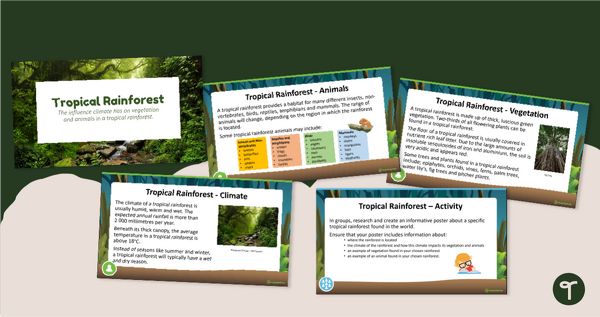
Tropical Rainforest PowerPoint
An 11 slide editable PowerPoint to use in the classroom when learning about tropical rainforests.
- Free Plan

Desert Word Wall Vocabulary
Spark discussion and build academic vocabulary with a desert related vocabulary word wall.
- Plus Plan

My Personal Timeline - Project Template
Apply knowledge of chronological order while students create a personal timeline highlighting important milestones.
- Plus Plan

Renewable or Nonrenewable? - Self-Checking Interactive
Investigate the differences between renewable and nonrenewable resources with a self-checking interactive science game.
- Plus Plan
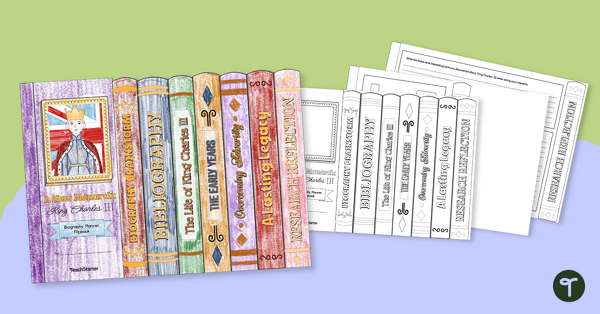
King Charles III Biography Planner Flipbook
Research and learn about King Charles III and discover biography writing.
- Plus Plan

Save the Planet - Kids Mini Book
Teach your students to reduce, reuse, and recycle with a printable Save the Planet kid's book.
- Plus Plan
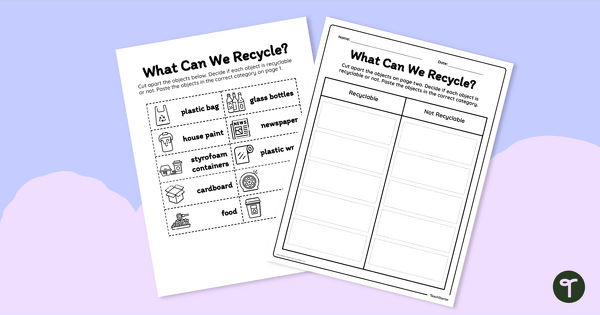
What Can We Recycle? Cut and Paste Worksheet
Remember what to recycle with a cut-and-paste worksheet.
- Plus Plan

Being Water Wise - Saving Water Poster Project
Learn and demonstrate knowledge about water conservation with a "Being Water Wise" poster project.
- Plus Plan

How to Save Water Poster and Worksheet Pack
Teach your students ways to save water with a printable poster and worksheet pack.
- Plus Plan

A World Without Water - Natural Resource Worksheet
Imagine and depict what a world without water would look like with a drawing prompt worksheet.
- Plus Plan

How Do We Use Natural Resources? Concept Map Worksheet
Help your students uncover the ways that humans use natural resources with a concept map.
- Plus Plan

How Can We Help Our Planet Mini Book
Help your students learn about how to keep our planet clean with a printable Earth Day book.
- Plus Plan

I Promise To... Earth Day Flip Book Craft
Make a promise to protect the planet with a printable Earth Day flip book.
- Plus Plan

Reduce, Reuse, Recycle, Rethink and Repair Posters
Explain the concepts behind reducing, reusing, recycling, rethinking and repairing waste with a set of printable sustainability posters.
- Plus Plan

Changes to the Environment – Worksheet
Learn about environmental changes and how they affect living things with this worksheet.
- Plus Plan

National Tree Day – Why Plant a Tree? Infographic Analysis Activity
Teach about the importance of trees on National Tree Day with an infographic poster and cloze note-taking worksheet.
- Plus Plan

Renewable and Nonrenewable Resources – Crossword Puzzle
Reinforce science vocabulary with a renewable and nonrenewable resources crossword puzzle.
- Plus Plan

Energy Saving Reminders
Inspire your students to conserve electricity with these energy-saving reminders that can be placed around the classroom.
- Plus Plan

Natural Resources Task Cards
Answer questions about natural resources and their uses with this set of 16 task cards.
- Plus Plan

How We Use Natural Resources Printable Book
Read and learn about how we use natural resources with a printable mini-book.
- Plus Plan

Match It Up! Natural Resources – Worksheet
Match natural resources with how they are used with the help of this worksheet.
- Plus Plan

Natural Resources Task Cards - Journal Writing Prompts
Integrate science and writing while responding to specific scenarios regarding natural resources with this set of 24 journal task cards.
- Plus Plan
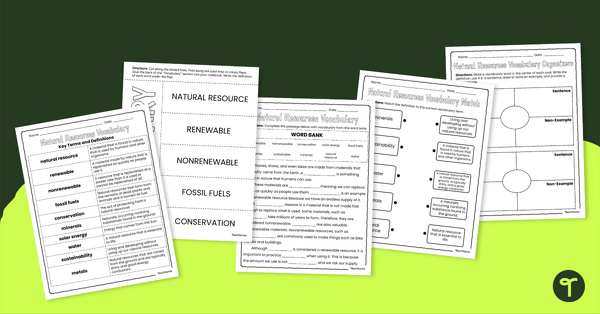
Natural Resources Vocabulary Worksheets
Practise and review vocabulary terms associated with natural resources with this worksheet pack.
- Plus Plan

Oil Spill Science Experiment
Investigate water pollution and discover the effects of oil spills on wildlife with a hands-on science lab!
- Plus Plan
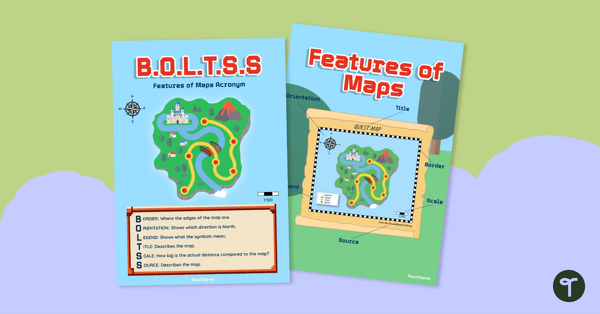
B.O.L.T.S.S Features of Maps Posters for the Classroom
Teach the BOLTSS mnemonic and explore the features of maps using this set of colourful classroom posters.
- Plus Plan

Environmental Awareness Flip Book - Earth Day Activity
Use this flip book to build awareness of actions that are good and bad for the environment.
- Plus Plan

Features of Maps - Exit Tickets
Assess student map and globe skills with twenty exit ticket worksheets.
- Plus Plan

Features of Maps - Question Prompt Task Cards
Assess your students' understanding of the features of maps with this set of 16 question prompt task cards.